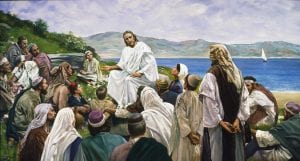
Catechism Lesson 13: The Life of Jesus Christ (Part 2)
The Baptism of Christ
The public life of Christ began with His baptism by John the Baptist in the Jordan river (Luke 3:23). While John was baptizing sinners with a “baptism of repentance,” Jesus appeared. John hesitated, but Jesus insisted and received baptism. Then the Holy Spirit, in the form of a dove, comes upon Jesus and a voice from heaven proclaimed: “This is my beloved Son. (Matthew 3:13-17)”
The baptism of Christ was His acceptance and inauguration of His mission as God’s suffering servant (cf. Isaiah 51); it also anticipated the “baptism” of His own bloody death on the Cross. Even as John proclaimed Jesus as “the Lamb of God who takes away the sins of the world (John 1:29),” Jesus allowed Himself to be counted among sinners. Jesus submitted Himself entirely to the Father’s will out of love and consented to a baptism of death for the remission of sins. (CCC 536)
The Temptation of Christ
After His baptism, Jesus was driven to the desert by the Spirit, where He remained for forty days without eating (Mark 1:12-13). Then Satan came to tempt Jesus three times, in order to compromise His obedience to the Father’s will. Jesus rebuffs these temptations, and the devil leaves him until an opportune time (Luke 4:13).
The Temptation of Christ signifies that Jesus is the new Adam; whereas the first Adam gave in to temptation, Jesus did not give in to temptation and remained faithful. Jesus is also the devil’s conqueror; as Jesus overcame the temptations of the devil in the desert, He will also overcome suffering and death and emerge victorious at His Resurrection. (CCC 593)
The Galilean Ministry
Jesus went to Galilee and preached the Gospel; Jesus proclaimed: “The Kingdom of God is at hand; repent and believe in the Gospel. (Mark 1:14-15)” Jesus went to the synagogue to teach; the people who heard Jesus were astonished at His teaching because unlike the scribes, He taught as one having authority (Mark 1:21-22).
Jesus chose twelve men so that they might be with Him, and that He might send them forth to preach and to have authority to drive out demons: Simon, whom He named Peter; James, son of Zebedee, and John the brother of James, whom he named Boanerges, that is, sons of thunder; Andrew, Philip, Bartholomew, Matthew, Thomas, James the son of Alphaeus; Thaddeus, Simon the Cananean, and Judas Iscariot who betrayed him (Mark 3:16-19).
As Jesus proclaimed the Gospel, He performed many mighty works and signs; these miracles attested that the Father has sent Him and that He was the promised Messiah. Jesus also healed the sick and drove out demons; but most of all, Jesus forgave sins in order to free men from the greatest slavery of all – sin. (CCC 547-549)
Jesus preached the Kingdom of God to the crowds and taught them the Beatitudes (Matthew 5:1-12). Jesus also taught the crowds concerning anger, adultery and divorce, oaths, love of enemies, fasting and almsgiving, treasures in heaven, judging others, praying to God, etc. Jesus also taught the crowds in parables. Jesus and the presence of the Kingdom of God in this world are at the heart of the parables. One must enter the Kingdom, that is, become a disciple of Christ, in order to know the secrets of the Kingdom of heaven. For those who stay outside, everything remains a mystery. (cf. Mark 4:11-12; CCC 546)
Questions:
- When did the public life of Christ begin?
- What does the baptism of Christ signify?
- What does the temptation of Christ signify?
- What are the names of the twelve men that Jesus called as His disciples?
- True or False. Jesus performed miracles so that the people will believe in magic.
- Name at least three things which Jesus taught about.
- Read Matthew 5:1-12. What are the eight Beatitudes which Jesus taught?